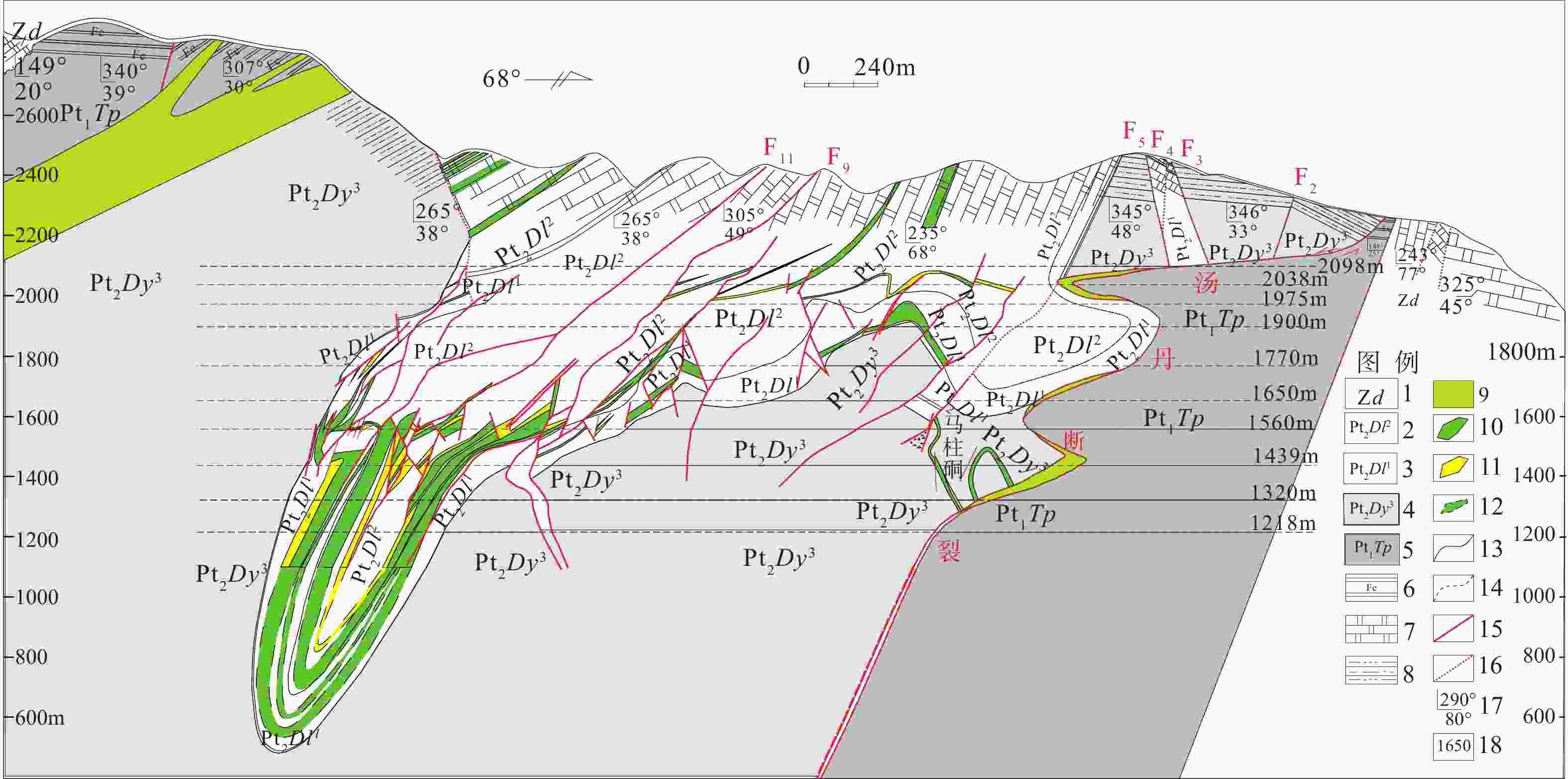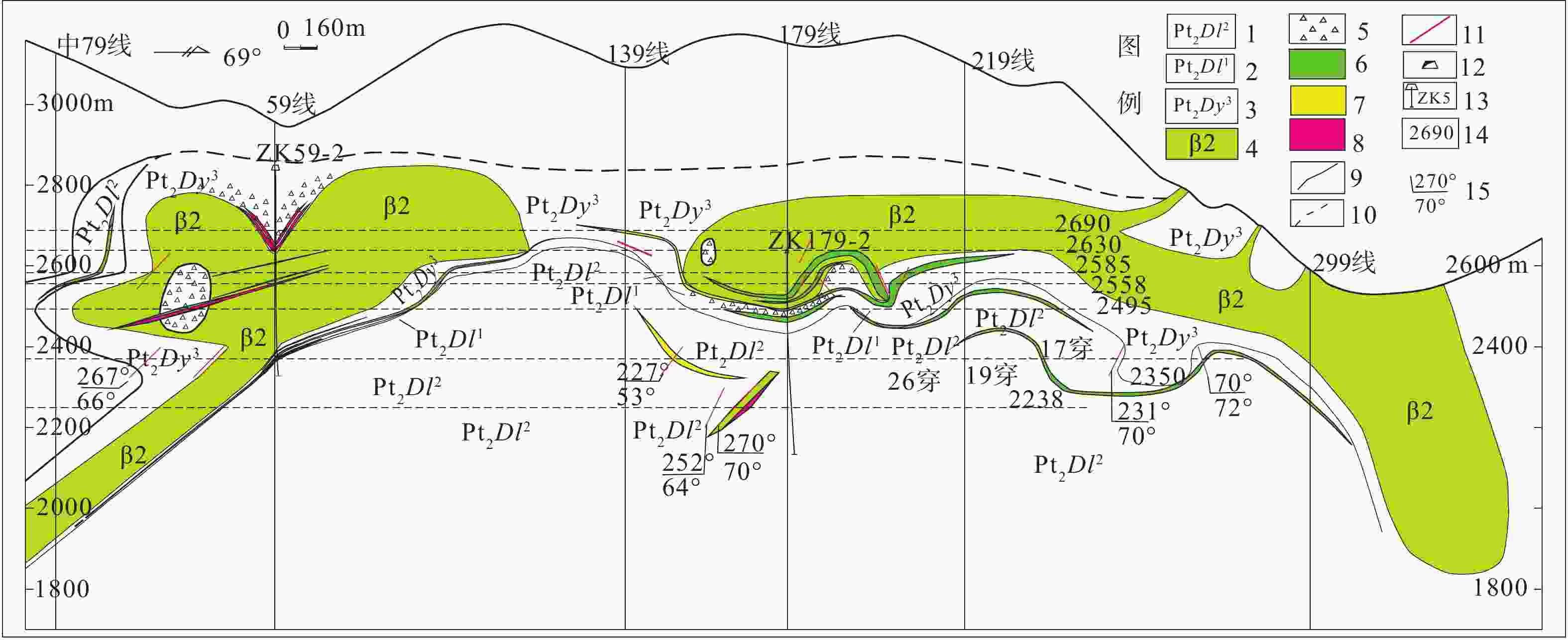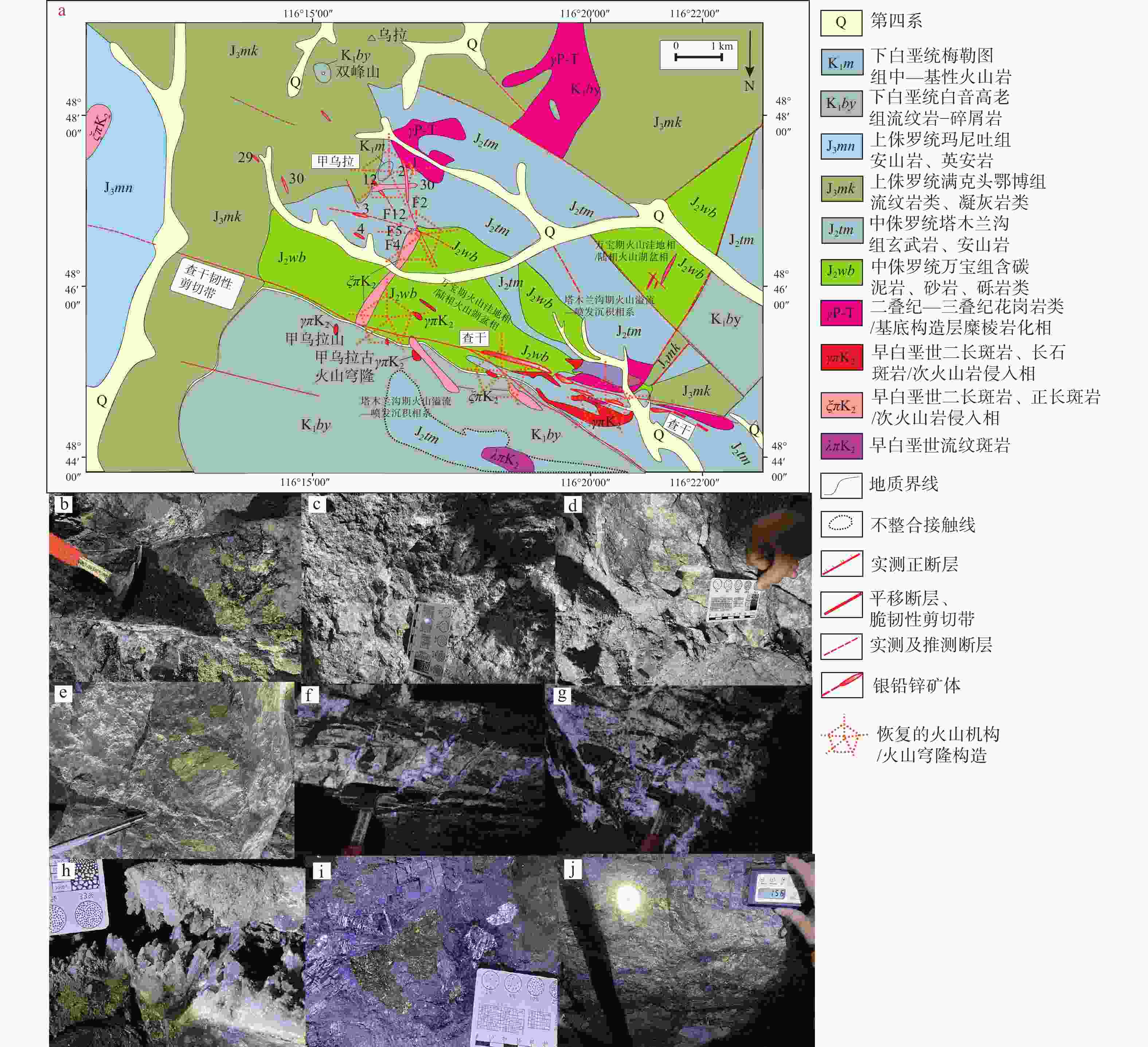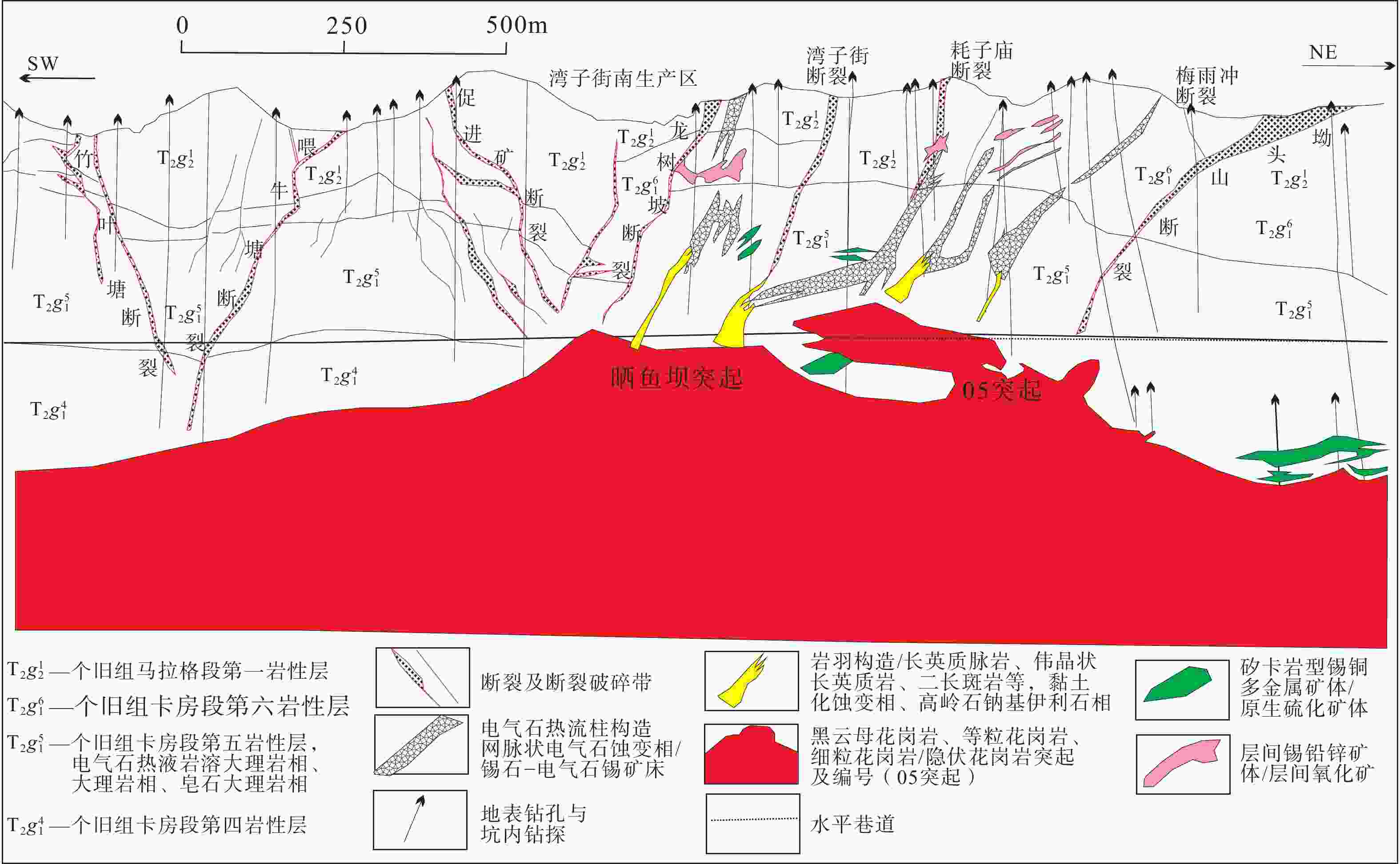Theoretical innovation and applications of ore-field tectonic lithofacies mapping
-
摘要: 开展成矿蚀变−构造岩相解析建相和建模预测研究已成为矿田构造与找矿预测的创新方向之一。文章对国内外8类重要的成矿蚀变−构造岩相模型和形成机制进行论述总结,南美洲智利科皮亚波地区IOCG型矿田受到主岛弧带−弧相关盆地及岩浆叠加−盆地变形样式的复合控制,而中国云南东川沉积岩型铜矿床(SSC型)+IOCG型铁铜矿田受陆缘裂谷盆地、盆地变形构造样式和岩浆叠加侵入构造系统的复合控制。中国内蒙古甲−查浅成低温热液型银铅锌矿田受火山洼地、火山穹隆构造、火山岩岩相类型和火山热液隐爆角砾岩的复合控制,而深成岩浆弧控制了蒙古国南戈壁斑岩型金铜钼−浅成低温热液金银矿田;中国秦岭热水沉积型(SEDEX)银铜铅锌−菱铁矿−重晶石矿田受到陆缘拉分盆地内三级热水沉积盆地、同生断裂带和热水沉积岩相的控制。大陆造山带内不同层次的脆韧性剪切带,控制了金矿田和金钼多金属矿田定位。在新疆塔西盆−山−原镶嵌区盆地系统内,侏罗系煤系烃矿源岩是金属矿田和天然气气田的成矿成藏物质供给源区;乌拉根砂砾岩型天青石−铅锌矿田受到山前挤压—伸展转换盆地、气成热流柱构造和山前冲断褶皱带的复合控制;萨热克铜多金属矿田赋存于旱地扇杂砾岩,受到对冲式厚皮型逆冲推覆断裂带和幔源热流柱带的复合控制。其中在矿集区−矿田尺度上,电气石热流柱构造、岩浆气囊构造、复合岩溶构造岩相等是成矿蚀变−构造岩相的3种新类型;在归纳前期对矿田构造岩相、矿田构造古地理单元和典型矿田构造岩相形成机制研究基础上,文章提出了矿田成矿蚀变−构造岩相类型的新划分方法和划分原则方案,并划分确定了12种变形构造岩相类型。研究成果为矿田构造研究和找矿预测提供了新理论和新方法支撑。Abstract:
Objective In the matter of material architecture, the diagenetic-metallogenic system may be classified into lithofacies of root-feeders (metallogenic material feeders), lithofacies of structural channel (migration of diagenetic-metallogenic material), lithofacies of closed-reservoir space (unloading-enriching room of diagenetic-metallogenic material), and lithofacies of surrounding rock alteration (water–fluid–rock system of diagenetic-metallogenic material). Ore-field tectonic lithofacies mapping and detailed analysis of the formation mechanism of different types of tectonic lithofacies aid in identifying and delineating in-situ diagenetic-metallogenic systems at the scale of ore clusters and ore fields. These approaches also reveal the formation mechanisms of resources, energy, and minerals, marking it as an innovative direction in ore-field structure and prospecting prediction. In order to promote and deepen the research and understanding of tectonic lithofacies and prospecting prediction in ore fields, this article focused on the lithofacies establishment and modeling predictions on the mineralization-alteration-tectonics-lithofacies, discussing and exploring eight important types of mineralization-alteration-tectonics-lithofacies models and their formation mechanisms domestically and internationally. Methods The article carried out ore field tectonic lithofacies mapping and detailed analysis of the formation mechanism of different types of tectonic lithofacies in order to recognize and delineate in situ diagenetic-metallogenic systems at the scale of ore clusters and ore fields. Results Eight models and formation mechanisms for the mineralization-alteration-tectonics-lithofacies at the scale of ore-field tectonic lithofacies were discussed in this study. The IOCG-type ore field in the Copiapo area of Chile is controlled by the main arc belt, arc-related basins, magmatic superimposing and basin–deformation style. However, the SSC-type Cu deposit and the IOCG-type ore field in the Dongchuan area of Yunnan in southwestern China are located at the marginal rift basin with different styles of basin deformation and reworked by the magmatic superimposing tectonic system. The Jia–Cha epithermal Au-Ag-Pb-Zn ore-field in Inner Mongolia of northern China is dominated by volcanic lake-basin, volcanic dome structure, facies-type of volcanic rocks, and volcanic hydrothermal crypto-explosive breccias, whereas porphyry Cu-Mo-Au and epithermal Au-Cu ore-fields in the South Gebi area of Mongolia are formed in the Devonian–Carboniferous plutonic magmatic arc. The Sedex-type Ag-Cu-Pb-Zn-Ba-Fe ore-field in the Qinling orogeny of central China is shaped by the three-order sub-basin, syngenesis fault, and facies of hydrothermal sedimentary rock in the marginal pull-apart basin. However, gold and Au-Mo-polymetallic ore fields are dominated by different scales of the brittle-ductile shear zones in the orogenic belt. Migrations of the ore-reservoir-forming matters for metallic ore field and gas field are derived from the Jurassic coal-measure hydrocarbon-metal-bearing source rocks in the western Tarim of basin-mountain-plateau mosaic structure in western China. The Wulagen glutenite-type celesite-Pb-Zn ore field located at the piedmont compression to extension conversion basin is coupled by the pneumatogenic plume and superimposed by the piedmont thrust-fold belt. The Sareke glutenite-type Cu-polymetallic ore-field hosted at irony glutenite of the dry-fan facies in the tail-end lake basin is reworked by the hedging-style, base-type thrust fold belt and superimposed by mantle-derived hydrothermal plume. Conclusion Eight models and formation mechanisms for the mineralization-alteration-tectonics-lithofacies at the scale of ore field tectonic lithofacies were discussed in this study based on a review of ore-field tectonics. The tourmaline-rich plume tectonics, magmatic gasbag structure, and compound karsting tectonic lithofacies are three new types of mineralization-alteration-tectonics-lithofacies. Ore-field tectonic paleogeographic unit and formation mechanism of important ore-field tectonic lithofacies, new classification methods and principles of the mineralization-alteration-tectonics-lithofacies and 12 different types of deformational tectonic lithofacies were established in this essay. Significance All achievements in this study have established a new foundation for tectonic lithofacies mapping and ore prediction. -
图 1 汤丹铜矿床(SSC型)4号构造岩相学实测纵剖面
1—震旦系陡山沱组;2—中元古界东川群落雪组二段;3—中元古界东川群落雪组一段; 4—中元古界东川群因民组三段;5—古元古界汤丹岩群平顶山组;6—铁质板岩;7—白云岩; 8—泥粉砂质板岩;9—碱性铁质辉绿辉长岩枝(墙);10—铜矿体(SSC型铜矿床);11—低品位铜矿体; 12—推测铜矿体;13—地质界线; 14—推测地质界线;15—断层;16—推测断层; 17—地质产状;18—中段标高和海拔高度
Figure 1. Measured No.4 longitudinal profiles of tectonic lithofacies in the Tangdan copper deposits (SSC-type)
1−Sinian Doushantuo Formation; 2−the Second of member at Luoxue Formation of Mesoproterozoic Dongchuan Group; 3−the first member at Luoxue Formation of Mesoproterozoic Dongchuan Group; 4−the three member at Yinming Formation of Mesoproterozoic Dongchuan Group; 5−Pingdingshan Formation of Palaeoproterozoic Tangdan Rock Group; 6−irony slate; 7−dolomite; 8−argillaceous-silty slate; 9−alkaline Fe-rich diabase-gabbro apophyse or dike; 10−copper orebody(SSC-type copper deposit);11−copper orebody with low-grades; 12−presumed copper orebody;13−geological line; 14−presumable geological line;15−faults; 16−presumed faults; 17−geological occurrence; 18−adit level and above the sea level
图 2 白锡腊−中老龙IOCG型和SSC型铜矿床实测构造岩相学纵剖面
1—中元古界东川群落雪组二段;2—中元古界东川群落雪组一段;3—中元古界东川群因民组三段;4—碱性铁质辉绿辉长岩枝;5—热液角砾岩相;6—铜矿体(SSC型铜矿床);7—低品位铜矿体;8—铁铜矿体(IOCG型铁铜矿床);9—地质界线;10. —推测地质界线;11—断层;12—穿脉垂直投影面;13—坑内钻孔及编号;14—中段标高和海拔高度;15—地质产状
Figure 2. Measured longitudinal profiles of tectonic lithofacies for IOCG-type and SSC-type copper deposits from Baixila to Zhonglaolong
1−the second of member of the Luoxue Formation of the Mesoproterozoic Dongchuan Group; 2−the first member of the Luoxue Formation of the Mesoproterozoic Dongchuan Group; 3−the third member of the Yinming Formation of the Mesoproterozoic Dongchuan Group; 4−alkaline Fe-rich diabase-gabbro apophyse; 5−hydrothermal breccia facies; 6−copper orebody (SSC-type copper deposit); 7−low-grade copper orebody; 8−Fe-Cu orebody (IOCG-type deposit); 9−geological boundary; 10−inferred geological boundary; 11−fault; 12−transverse drift (vertical projection); 13−adit-in drillhole and its number; 14−adit elevation and altitude
图 3 甲查银多金属矿田火山机构与矿田构造岩相图
a—甲乌拉−查干银多金属矿田构造岩相图;b—e、h—j为甲乌拉银多金属矿床;f—g为查干银多金属矿床;b—540 m中段铅锌硫化物充填交代脉与边部菱沸石−铁绿泥石相;c—580 m中段石膏−蒙脱石−钾伊利石相;d—580 m中段伊蒙混层−伊利石相;e—475 m中段细脉状和微脉状闪锌矿方铅矿硫化物充填在伊利石热液角砾岩相中。 f—怡圣园西端18号矿体300 m中段216勘探线主巷道掌子面富银菱锰矿铁锰碳酸盐热液角砾岩相;g—怡圣园西端18号矿体300 m中段216勘探线主巷道掌子面富银菱锰矿铁锰碳酸盐热液角砾岩相;h—200 m中段5′—7′线含闪锌矿方铅矿马牙状石英脉;i—伟晶状方铅矿结晶核相;j—200 m中段5′—7′线2号矿体巨晶状方铅矿结晶核相的外缘中心相(具有海绵陨铁结构的铁闪锌矿−磁黄铁矿−黄铜矿矿石,磁化率151~114×10−3SI)
Figure 3. Mapping of volcanic edifice and ore-field tectonic lithofacies in the Jia–Cha Ag-polymetallic orefield
(a) Tectonic lithofacies map of the Jiawula–Chagan Ag-polymetallic orefield; Fig.3b to 3e and 3h to 3i are photos from the Jiawula Ag-polymetallic deposit and Fig.3f to 3g are photos from the Chagan Ag-polymetallic deposit; (b) Chabasite-daphnite facies along both sides of the filling−replacement veins of Pb-Zn-sulfides at 540 m level; (c) Gypsum-semctite-K-illite facies at 580 m level; (d) Facies of illite-smectite formation and illite at 580 m level; (e) Fine-veined and microveined sphalerite-galena sulfides veins filling in lithofacies of illite hydrothermal breccia at 475 m level; (f) Fe-Mn-carbonate hydrothermal breccia lithofacies of Ag-rich rhodochrosite from No.18 orebody in the 216 exploration line at the tunnel face of 300 m level; (g) Fe-Mn-carbonate hydrothermal breccia lithofacies of Ag-rich rhodochrosite from No.18 orebody in the 216 exploration line at the tunnel face of 300 m level; (h) Sphalerite-galena sulfides quartz veins in horse-teeth-shape in the 5′–7′ exploration line at 200 m level; (i) Crystalline nuclear lithofacies of pegmatitic galena in the 5′–7′ exploration line at 200 m level; (j) Marmatite-pyrrhotite-chalcopyrite ores in sideronitic texture around crystalline nuclear lithofacies of pegmatitic galena in the 5′–7′ exploration line at 200 m level; magnetic susceptibility is from 151×10−3 to 114×10−3SI
-
[1] CAO P, REN Y S, HOU Z S, et al. , 2018. Ore-forming fluid characteristics and mineralization age of the Jiawula Pb-Zn (Ag) Deposit in Manzhouli area[J]. Gold, 39(9): 5-12. (in Chinese with English abstract) [2] CHEN H Y, ZHANG S T, CHU G B, et al. , 2019. The short wave infrared (SWIR) spectral characteristics of alteration minerals and applications for ore exploration in the typical skarn-porphyry deposits, Edong ore district, eastern China[J]. Acta Petrologica Sinica, 35(12): 3629-3643. (in Chinese with English abstract) doi: 10.18654/1000-0569/2019.12.04 [3] CHEN X H, CHEN Z L, YANG N, 2009. Study on regional mineralizations and ore-field structures: building of mineralizing tectonic systems[J]. Journal of Geomechanics, 15(1): 1-19. (in Chinese with English abstract) [4] CHEN Z L, CHEN B L, 2012. Thinking, steps and practice of research on orefield structure in geomechanics[J]. Chinese Journal of Nature, 34(4): 208-215. (in Chinese with English abstract) [5] CLOUTIS E A, 1989. Spectral reflectance properties of hydrocarbons: remote-sensing implications[J]. Science, 245(4914): 165-168. doi: 10.1126/science.245.4914.165 [6] COOKE D R, WILSON A J, DAVIES A G S, 2004. Characteristics and genesis of porphyry copper-gold deposits[R]. Hobart: University of Tasmania: 17-34. [7] DAI M, YAN G S, LIU C, et al. , 2016. The zircon U-Pb geochronology and the geochemistry of magmatic rocks and their constraints on the mineralization of Jiawula Pb-Zn-Ag deposit, Inner Mongolia, China[J]. Earth Science Frontiers, 23(5): 266-280. (in Chinese with English abstract) [8] FANG W X, LIU Y L, ZHANG S L, et al. , 2009. Three types of continental geodynamics and metallogenic models for IOCG (Iron-oxide copper gold deposits) from the global view[J]. Journal of Northwest University (Natural Science Edition), 39(3): 404-413. (in Chinese with English abstract) [9] FANG W X, 2012. R&D on new mapping technology of geochemical lithofacies in prediction and exploration for Iron-Oxide Copper Gold deposits (IOCG)[J]. Advances in Earth Science, 27(10): 1178-1184. (in Chinese with English abstract) [10] FANG W X, LIU X Y, LIU Y L, et al. , 2012. Trial applications of lithofacies mapping in the Baixila Fe-Cu Ore district, Dongchuan, Yunnan, and their achievements of prospecting predication[J]. Acta Mineralogica Sinica, 32(1): 101-114. (in Chinese with English abstract) doi: 10.5846/stxb201011021569 [11] FANG W X, DU Y L, LI J X, et al. , 2018. Large scale structural petrography mapping technology and prospecting prediction[M]. Beijing: Geology Press: 1-394. (in Chinese) [12] FANG W X, 2019. Magmatic intrusive tectonic system I: tectonic lithofacies mapping and ore-predication[J]. Geotectonica et Metallogenia, 43(3): 473-506. (in Chinese with English abstract) [13] FANG W X, 2020. Classification and types of diagenetic lithofacies systems in the Sedimentary Basin[J]. Geological Bulletin of China, 39(11): 1692-1714. (in Chinese with English abstract) [14] FANG W X, GUO Y Q, JIA R X, et al. , 2021. On relationship between the superimposed mineralization systems and the zoning patterns of vertical tectonic lithofacies in the Gejiu concentration area of Sn-Cu-W and three rare metals in Yunnan[J]. Journal of Geomechanics, 27(4): 557-584. (in Chinese with English abstract) [15] FANG W X, 2022a. On research methodology for deformation history of tectonic lithofacies in sedimentary basin and their application[J]. Journal of Geomechanics, 28(1): 1-21. (in Chinese with English abstract) [16] FANG W X, 2022b. On tectonic lithofacies of hypogene paleokarst unconformable tectonic systems and metallic mineralization[J]. Acta Geologica Sinica, 96(7): 2585-2610. (in Chinese with English abstract) [17] FANG W X, 2023. Hydrothermal sedimentary lithofacies and their tectono-palaeogeography[J]. Journal of Palaeogeography (Chinese Edition), 25(3): 525-553. (in Chinese with English abstract) [18] HAN R S, WANG F, HU Y Z, et al. , 2014. Metallogenic tectonic dynamics and chronology constrains on the Huize-type (HZT) germanium-rich silver-zinc-lead deposits[J]. Geotectonica et Metallogenia, 38(4): 758-771. (in Chinese with English abstract) [19] HOU Z Q, COOK N J, 2009. Metallogenesis of the Tibetan collisional orogen: a review and introduction to the special issue [J]. Ore Geology Reviews, 36(1-3): 2-24HOU Z Q, YANG Z M, LU Y J, et al. , 2015. A genetic linkage between subduction- and collision-related porphyry Cu deposits in continental collision zones [J]. Geology, 43(3): 247-250. doi: 10.1130/G36362.1 [20] HOU Z Q, CHEN J, ZHAI M G, 2020. Current status and frontiers of research on critical mineral resources [J]. Chinese Science Bulletin, 65(33): 3651-3652. (in Chinese with English abstract) doi: 10.1360/TB-2020-1417 [21] HU R Z, WEN H J, YE L, et al. , 2020. Metallogeny of critical metals in the Southwestern Yangtze Block [J]. Chinese Science Bulletin, 65(33): 3700-3714. (in Chinese with English abstract) doi: 10.1360/TB-2020-0274 [22] HUANG J H, CHEN H Y, HAN J S, et al. , 2018. Alteration zonation and short wavelength infrared (SWIR) characteristics of the Honghai VMS Cu-Zn deposit, Eastern Tianshan, NW China [J]. Ore Geology Reviews, 100: 263-279. doi: 10.1016/j.oregeorev.2017.02.037 [23] LI J X, FANG W X, LIU J J, 2011. Types and characteristics of regional tectonics and ore-field structures of iron oxide-copper-gold deposits in Chile [J]. Geology and Exploration, 47(2): 323-332. (in Chinese with English abstract) [24] LI T C, FANG W X, WANG L, et al. , 2022. Application of integrated geophysical method in prospecting: a case study of the magnetite-type IOCG deposits in the Moon Mountain exploration area, Copiapo, Chile [J]. Journal of Geomechanics, 28(1): 22-35. (in Chinese with English abstract) [25] LI T G, WU G, LIU J, et al. , 2014. Rb-Sr isochron age of the Jiawula Pb-Zn-Ag deposit in the Manzhouli area and its geological significance[J]. Acta Petrologica Sinica, 30(1): 257-270. (in Chinese with English abstract) [26] LI SZ, LIU LJ, SUO YH, et al. , 2023. Carbon Tectonics: A new paradigm for Earth system science [J]. China Science Bullet, 68(4): 309 –338. doi: 10.1360/TB-2022-0741 [27] LIU F, WANG L, HAN R S, et al. , 2017. Ore-field structural system and its ore-controlling processes of the Beiya porphyry gold polymetallic deposit in northwestern Yunnan, China[J]. Earth Science Frontiers, 24(6): 208-224. (in Chinese with English abstract) [28] LOWELL J D, GUILBERT J M, 1970. Lateral and vertical alteration-mineralization zoning in porphyry ore deposits[J]. Economic Geology, 65(4): 373-408. doi: 10.2113/gsecongeo.65.4.373 [29] LÜ G X, ZHANG B L, HU B Q, et al. , 2020. Classification and application effect of structural deformation lithofacies in the orefield [J]. Geological Bulletin of China, 39(11): 1669-1680. (in Chinese with English abstract) [30] LÜ Q T, MENG G X, YAN J Y, et al. , 2019. Multi-scale exploration of mineral system: concept and progress: a case study in the middle and lower reaches of the Yangtze River Metallogenic Belt[J]. Geology in China, 46(4): 673-689. (in Chinese with English abstract) [31] LÜ Z C, CHEN H, MI K F, et al. , 2022. The theory and method of ore prospecting prediction for exploration area: case studies of the Lala copper deposit in Sichuan, Muhu-Maerkantu manganese ore deposit in Xinjiang and Aonaodaba tin-polymetallic deposit in Inner Mongolia[J]. Journal of Geomechanics, 28(5): 842-865. (in Chinese with English abstract) [32] MAO J W, WU S H, SONG S W, et al. , 2020. The world-class Jiangnan tungsten belt: geological characteristics, metallogeny, and ore deposit model [J]. Chinese Science Bulletin, 65(33): 3746-3762. (in Chinese with English abstract) doi: 10.1360/TB-2020-0370 [33] NIU S D, LI S R, GUO J, 2020. 40Ar-39Ar ages of the sericite in the Jiawula Pb-Zn-Ag deposit, Inner Mongolia and their geological significance[J]. Geology and Exploration, 56(1): 59-67. (in Chinese with English abstract) [34] SILLITOE R H, 2005. Supergene oxidized and enriched porphyry copper and related deposits [M]//HEDENQUIST J W, THOMPSON J F H, GOLDFARB R J, et al. One hundredth anniversary volume. Littleton: Society of Economic Geologists: 723-768. [35] SILLITOE R H, 2010. Porphyry copper systems [J]. Economic Geology, 105(1): 3-41. doi: 10.2113/gsecongeo.105.1.3 [36] XIAO W J, SONG D F, ZHANG J E, et al. , 2022. Anatomy of the structure and evolution of subduction zones and research prospects [J]. Earth Science, 47(9): 3073-3106. (in Chinese with English abstract) [37] XIU L C, ZHENG Z Z, YU Z K, et al. , 2007. Mineral analysis technology application with near infrared spectroscopy in identifying alteration mineral [J]. Acta Geologica Sinica, 81(11): 1584-1590. (in Chinese with English abstract) [38] YANG M, SUN J G, WANG Z Y, et al. , 2017. Petrogenesis and geological significance of the alkali-rich granite porphyry in the Jiawula Cu-Ag-Pb-Zn deposit in the Western slope of the great Xing’an range: zircon U-Pb dating and geochemical characteristics [J]. Journal of Jilin University (Earth Science Edition), 47(2): 477-496. (in Chinese with English abstract) [39] YANG S F, JIA C Z, CHEN H L, et al. , 2022. Core theories of sedimentary basin structure and the related key research techniques: frontiers and development directions [J]. Earth Science Frontiers, 29(6): 10-23. (in Chinese with English abstract) [40] YANG X K, LIU W, FAN Y, et al. , 2015. Type classification and Qinghai example analysis of orefield structure and magma-thermodynamic structure [J]. Journal of Earth sciences and Environment, 37(1): 24-36. (in Chinese with English abstract) [41] ZHAI Y S, 2007. Earth system, metallogenic system to exploration system [J]. Earth Science Frontiers, 14(1): 172-181. (in Chinese with English abstract) [42] ZHANG B L, LYU G X, YU J G, et al. , 2021. Geophysical data interpretation of the tectonic deformation lithofacies belts in the ore field: application in ore prospecting [J]. Journal of Geomechanics, 27(4): 542-556. (in Chinese with English abstract) [43] ZHANG S M, WANG G H, ZHAO S B, et al. , 2022. The Main magmstic-thermodynamic Structures and their controls on ore formation in Beishan, Inner Mongolia [J]. Geotectonica et Metallogenia, 46(4): 691-709. (in Chinese with English abstract) [44] ZHENG Y, 2022. Large-scaled structure-alteration-mineralization mapping of the hydrothermal deposits: basic principle and precautions[J]. Earth Science, 47(10): 3603-3615. (in Chinese with English abstract) [45] ZHOU Y Z, CHEN S, ZHANG Q, et al. , 2018. Advances and prospects of big data and mathematical geoscience [J]. Acta Petrologica Sinica, 34(2): 255-263. (in Chinese with English abstract) [46] ZOU C C, WANG C S, PENG C, et al. , 2023. Development of the Chinese continental scientific deep drilling: perspectives and suggestions[J]. Geoscience, 37(1): 1-14. (in Chinese with English abstract) [47] 曹鹏, 任云生, 侯召硕, 等, 2018. 满洲里地区甲乌拉铅锌(银)矿床成矿流体特征及成矿时代[J]. 黄金, 39(9): 5-12. doi: 10.11792/hj20180902 [48] 陈华勇, 张世涛, 初高彬, 等, 2019. 鄂东南矿集区典型矽卡岩-斑岩矿床蚀变矿物短波红外(SWIR)光谱研究与勘查应用[J]. 岩石学报, 35(12): 3629-3643. doi: 10.18654/1000-0569/2019.12.04 [49] 陈宣华, 陈正乐, 杨农, 2009. 区域成矿与矿田构造研究: 构建成矿构造体系[J]. 地质力学学报, 15(1): 1-19. doi: 10.3969/j.issn.1006-6616.2009.01.001 [50] 陈正乐, 陈柏林, 2012. 地质力学矿田构造研究思路、步骤与实践[J]. 自然杂志, 34(4): 208-215. [51] 戴蒙, 严光生, 刘翠, 等, 2016. 内蒙古甲乌拉铅锌银矿区岩浆岩年代学、地球化学特征及其对成矿的约束[J]. 地学前缘, 23(5): 266-280. [52] 方维萱, 柳玉龙, 张守林, 等, 2009. 全球铁氧化物铜金型(IOCG)矿床的3类大陆动力学背景与成矿模式[J]. 西北大学学报(自然科学版), 39(3): 404-413. [53] 方维萱, 2012. 论铁氧化物铜金型(IOCG)矿床地球化学岩相学填图新技术研发[J]. 地球科学进展, 27(10): 1178-1184. [54] 方维萱, 杨新雨, 柳玉龙, 等, 2012. 岩相学填图技术在云南东川白锡腊铁铜矿段深部应用试验与找矿预测[J]. 矿物学报, 32(1): 101-114. [55] 方维萱, 杜玉龙, 李建旭, 等, 2018. 大比例尺构造岩相学填图技术与找矿预测[M]. 北京: 地质出版社: 1-394. [56] 方维萱, 2019. 岩浆侵入构造系统Ⅰ: 构造岩相学填图技术研发与找矿预测效果[J]. 大地构造与成矿学, 43(3): 473-506. [57] 方维萱, 2020. 论沉积盆地内成岩相系划分及类型[J]. 地质通报, 39(11): 1692-1714. doi: 10.12097/j.issn.1671-2552.2020.11.003 [58] 方维萱, 郭玉乾, 贾润幸, 等, 2021. 论云南个旧锡铜钨三稀金属矿集区叠加成矿系统与垂向构造岩相学结构的关系[J]. 地质力学学报, 27(4): 557-584. [59] 方维萱, 2022a. 论沉积盆地构造岩相变形史研究方法及应用[J]. 地质力学学报, 28(1): 1-21. [60] 方维萱, 2022b. 深成古岩溶不整合构造系统构造岩相学与金属成矿[J]. 地质学报, 96(7): 2585-2610. [61] 方维萱, 2023. 论热水沉积岩相及其构造古地理[J]. 古地理学报, 25(3): 525-553. doi: 10.7605/gdlxb.2023.03.035 [62] 韩润生, 王峰, 胡煜昭, 等, 2014. 会泽型(HZT)富锗银铅锌矿床成矿构造动力学研究及年代学约束[J]. 大地构造与成矿学, 38(4): 758-771. doi: 10.3969/j.issn.1001-1552.2014.04.003 [63] 侯增谦, 陈骏, 翟明国, 2020. 战略性关键矿产研究现状与科学前沿[J]. 科学通报, 65(33): 3651–3652. [64] 胡瑞忠, 温汉捷, 叶霖, 等, 2020. 扬子地块西南部关键金属元素成矿作用[J]. 科学通报, 65(33): 3700-3714. [65] 李建旭, 方维萱, 刘家军, 2011. 智利铁氧化物-铜-金矿床区域定位构造-矿田构造类型与特征[J]. 地质与勘探, 47(2): 323-332. [66] 李天成, 方维萱, 王磊, 等, 2022. 综合地球物理方法找矿应用: 以智利科皮亚波地区月亮山磁铁矿型IOCG矿床为例[J]. 地质力学学报, 28(1): 22-35. doi: 10.12090/j.issn.1006-6616.20222802 [67] 李铁刚, 武广, 刘军, 等, 2014. 大兴安岭北部甲乌拉铅锌银矿床Rb-Sr同位素测年及其地质意义[J]. 岩石学报, 30(1): 257-270. [68] 李三忠, 刘丽军, 索艳慧, 等, 2023. 碳构造: 一个地球系统科学新范式[J]. 科学通报, 68(4): 309 –338. [69] 刘飞, 王雷, 韩润生, 等, 2017. 滇西北北衙斑岩型金多金属矿田构造体系及其控矿作用[J]. 地学前缘, 24(6): 208-224. [70] 吕古贤, 张宝林, 胡宝群, 等, 2020. 矿田构造变形岩相分类与应用效果[J]. 地质通报, 39(11): 1669-1680. doi: 10.12097/j.issn.1671-2552.2020.11.001 [71] 吕庆田, 孟贵祥, 严加永, 等, 2019. 成矿系统的多尺度探测: 概念与进展: 以长江中下游成矿带为例[J]. 中国地质, 46(4): 673-689. doi: 10.12029/gc20190401 [72] 吕志成, 陈辉, 宓奎峰, 等, 2022. 勘查区找矿预测理论与方法及其应用案例[J]. 地质力学学报, 28(5): 842-865. doi: 10.12090/j.issn.1006-6616.20222816 [73] 毛景文, 吴胜华, 宋世伟, 等, 2020. 江南世界级钨矿带: 地质特征、成矿规律和矿床模型[J]. 科学通报, 65(33): 3746-3762. [74] 牛斯达, 李胜荣, 郭健, 2020. 内蒙古甲乌拉铅锌银矿绢云母40Ar-39Ar年龄及其地质意义[J]. 地质与勘探, 56(1): 59-67. doi: 10.12134/j.dzykt.2020.01.006 [75] 肖文交, 宋东方, 张继恩, 等, 2022. 俯冲带结构演变解剖与研究展望[J]. 地球科学, 47(9): 3073-3106. doi: 10.3321/j.issn.1000-2383.2022.9.dqkx202209001 [76] 修连存, 郑志忠, 俞正奎, 等, 2007. 近红外光谱分析技术在蚀变矿物鉴定中的应用[J]. 地质学报, 81(11): 1584-1590. doi: 10.3321/j.issn:0001-5717.2007.11.013 [77] 杨梅, 孙景贵, 王忠禹, 等, 2017. 大兴安岭西坡甲乌拉铜银铅锌矿床富碱花岗斑岩的成因及其地质意义: 锆石U-Pb定年和地球化学特征[J]. 吉林大学学报(地球科学版), 47(2): 477-496. [78] 杨树锋, 贾承造, 陈汉林, 等, 2022. 沉积盆地构造核心理论和关键技术方法: 前沿与发展方向[J]. 地学前缘, 29(6): 10-23. [79] 杨兴科, 刘渭, 范阅, 等, 2015. 矿田构造与岩浆-热力构造的类型划分及青海实例分析[J]. 地球科学与环境学报, 37(1): 24-36. doi: 10.3969/j.issn.1672-6561.2015.01.003 [80] 翟裕生, 2007. 地球系统、成矿系统到勘查系统[J]. 地学前缘, 14(1): 172-181. doi: 10.3321/j.issn:1005-2321.2007.01.017 [81] 张宝林, 吕古贤, 余建国, 等, 2021. 矿田构造变形岩相带的地球物理资料解译与找矿应用[J]. 地质力学学报, 27(4): 542-556. doi: 10.12090/j.issn.1006-6616.2021.27.04.047 [82] 张善明, 王根厚, 赵士宝, 等, 2022. 北山内蒙地区主要岩浆‒热力构造类型及控矿作用分析[J]. 大地构造与成矿学, 46(4): 691-709. [83] 郑义, 2022. 热液矿床超大比例尺构造-蚀变-矿化填图: 基本原理与注意事项[J]. 地球科学, 47(10): 3603-3615. [84] 周永章, 陈烁, 张旗, 等, 2018. 大数据与数学地球科学研究进展: 大数据与数学地球科学专题代序[J]. 岩石学报, 34(2): 255-263. [85] 邹长春, 王成善, 彭诚, 等, 2023. 中国大陆科学深钻发展的若干思考与建议[J]. 现代地质, 37(1): 1-14. -





 下载:
下载:





